Menus
- Entry-level cruiser in a comparison test
- The Kawasaki Vulcan S engine comes from the ER-6
- Honda CTX 700 N with the most comfortable seat
- The acoustics of the CTX are reserved
- The Honda drives wonderfully balanced and round
- Harley-Davidson Street 750 has a slight handlebar flapping tendency
- Brake of the Vulcan S by far the best in the test field
- Processing of the Harley-Davidson Street 750 largely unfortunate
- Street 750 speedometer nice and simple
- Braking problems on the Harley-Davidson Street 750
- Technical specifications
- MOTORCYCLE test results
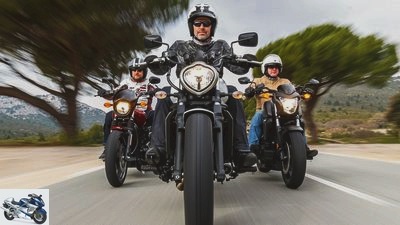
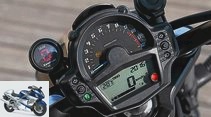
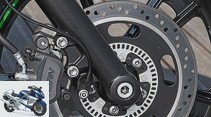
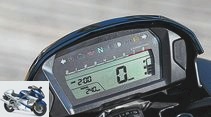
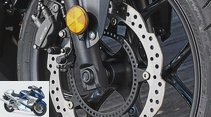
33 photos
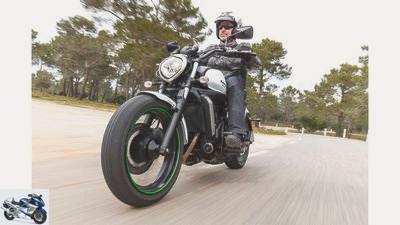
1/33
Kawasaki Vulcan S.
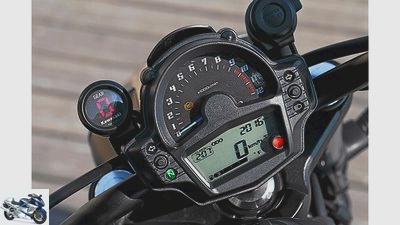
2/33
Kawasaki: Not chic, but functional. Tachometer good, digital speedometer not easy to read …
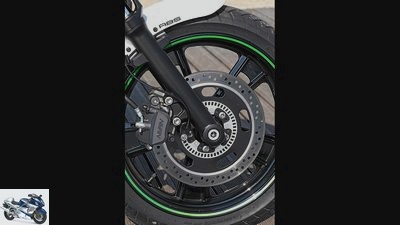
3/33
… That’s how it works: great ABS, great controllability, great delay for everyone.
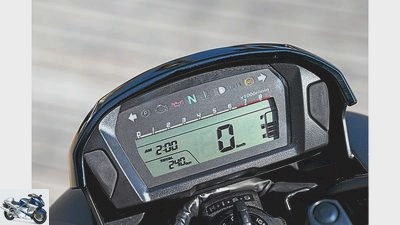
4/33
Honda: Generally not easy to read, but a similar amount of information as the Kawa …
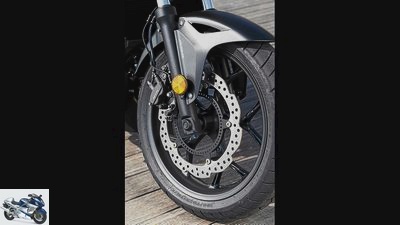
5/33
… Quite okay: good controllability and delay, but roughly regulating ABS.
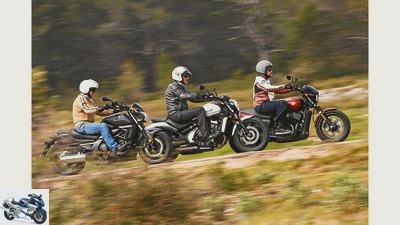
6/33
Kawasaki Vulcan S, Honda CTX 700 N and Harley-Davidson Street 750 in comparison test.
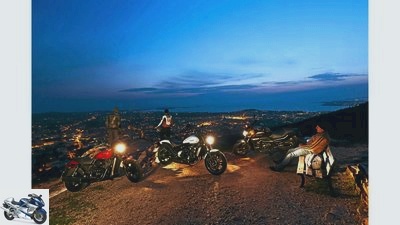
7/33
Kawasaki Vulcan S, Honda CTX 700 N and Harley-Davidson Street 750 in comparison test.
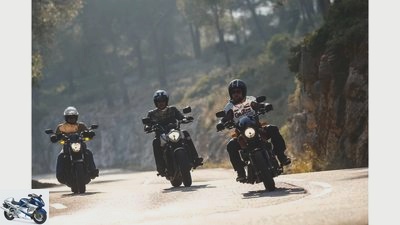
8/33
Kawasaki Vulcan S, Honda CTX 700 N and Harley-Davidson Street 750 in comparison test.
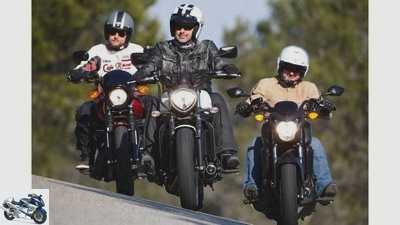
9/33
Kawasaki Vulcan S, Honda CTX 700 N and Harley-Davidson Street 750 in comparison test.
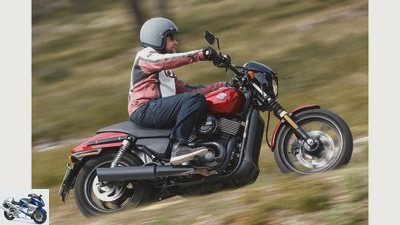
10/33
Harley-Davidson Street 750.
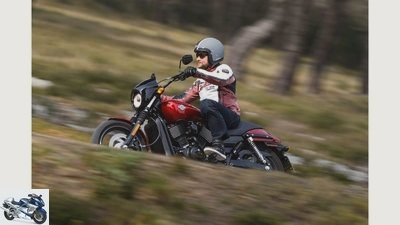
11/33
Harley-Davidson Street 750.
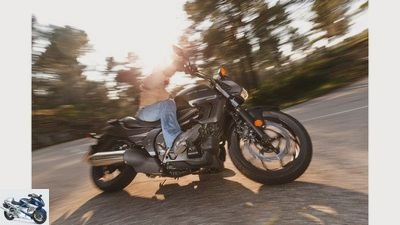
12/33
Honda CTX 700 N.
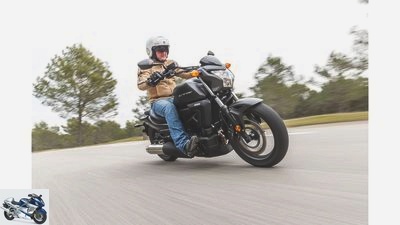
13/33
Honda CTX 700 N.
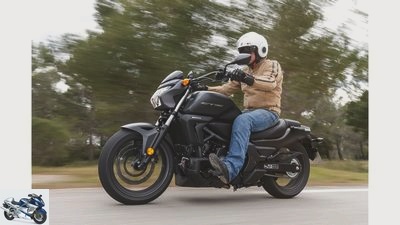
14/33
Honda CTX 700 N.
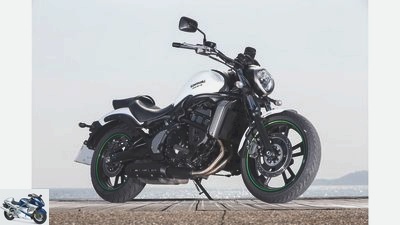
15/33
Kawasaki Vulcan S.
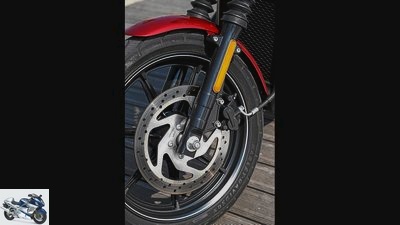
16/33
… No ABS, no controllability, braking effect only with far too much manual force.

17/33
Harley-Davidson: chic, classic speedometer, with daily and total kilometers. Very easy to read …
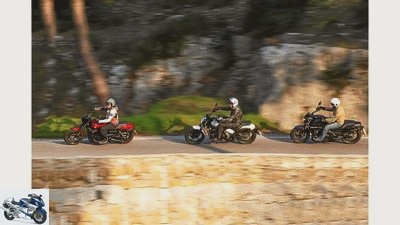
18/33
Kawasaki Vulcan S, Honda CTX 700 N and Harley-Davidson Street 750 in comparison test.
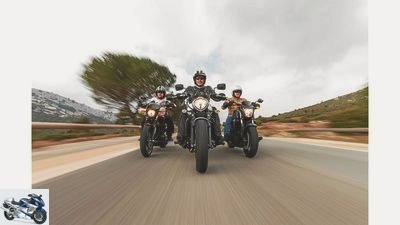
19/33
Kawasaki Vulcan S, Honda CTX 700 N and Harley-Davidson Street 750 in comparison test.
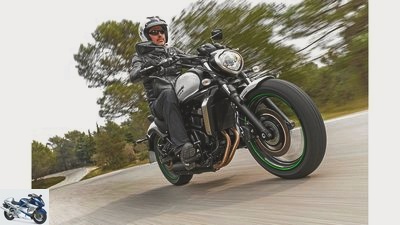
20/33
Kawasaki Vulcan S.
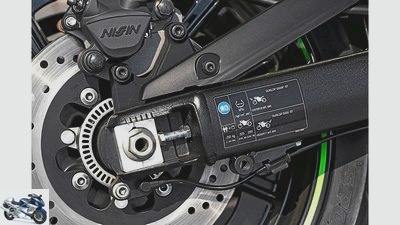
21/33
Clean and sensible: Well-made swing arm with a handsome chain tensioner, …
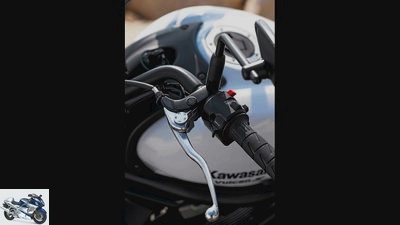
22/33
… adjustable brake and clutch lever (in the picture) – the Kawa impresses with its workmanship and equipment.
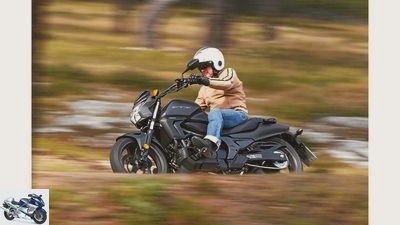
23/33
Honda CTX 700 N.
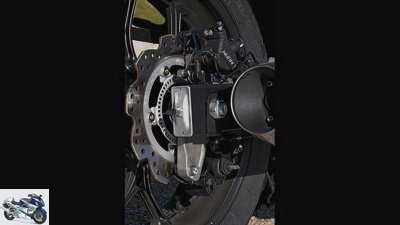
24/33
Selective and special: The saddle of the parking brake is easy to recognize (under the cheap-looking box swing arm) …
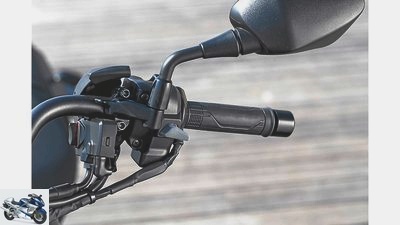
25/33
… There is no lever at the left end of the handlebar, but a button for selecting the gear of the DCT dual clutch transmission.
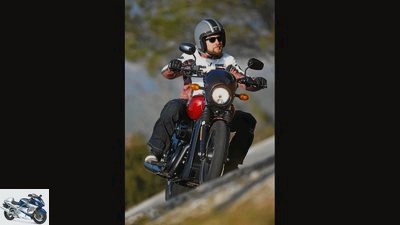
26/33
Harley-Davidson Street 750.
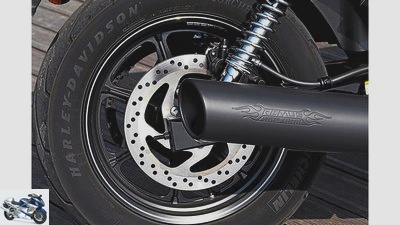
27/33
Sound and crooked: The Remus accessory rear silencer sounds very pithy to snotty …
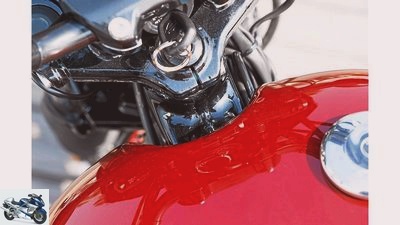
28/33
… Unfortunately, the quality of workmanship of the Street 750 is also snotty, illustrated here by the crookedly mounted tank.
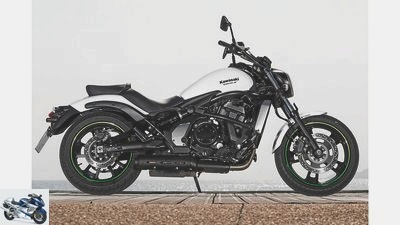
29/33
Simple to modern: long, low line, parallel twin from ER-6 / Versys. The pillion bun is removable, which suits the Kawasaki Vulcan S well.
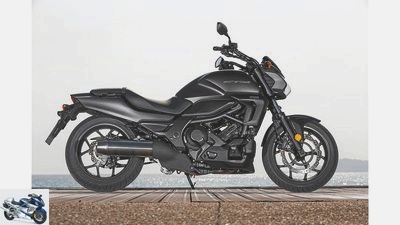
30/33
Honda CTX 700 N; Functional to spacey: also long and low, NC 700-Twin with character, DCT and low center of gravity, lots of plastic.
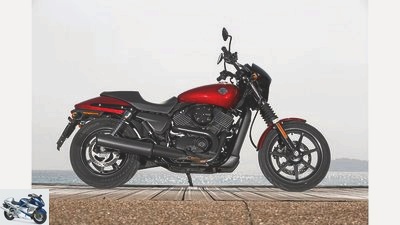
31/33
Harley-Davidson Street 750; Simple to classic, long and low anyway: water-cooled four-valve V2, still attractive from a distance.
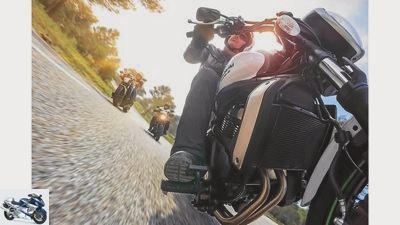
32/33
Kawasaki Vulcan S, Honda CTX 700 N and Harley-Davidson Street 750 in comparison test.
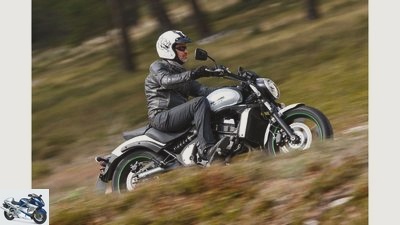
33/33
Kawasaki Vulcan S.
Kawasaki Vulcan S, Honda CTX 700 N and Harley-Davidson Street 750
Entry-level cruiser in a comparison test
Do you like it cozy? Do you leave the last groove and sweat under your helmet to the others? Would you rather swarm through the world with pleasure? Then you’ve come to the right place, the three entry-level cruisers Kawasaki Vulcan S, Honda CTX 700 N and Harley-Davidson Street 750 in a comparison test.
It had become quiet in the light cruiser class. Since the mega success of the Yamaha XV 535 Virago between 1988 and 2003, there had been little movement in this segment for around a decade. Last year, however, both Honda presented the Honda CTX 700 N and Harley-Davidson with the Harley-Davidson Street 750, two entry-level soft choppers. Now Kawasaki mixes with them Kawasaki Vulcan S with.
Buy complete article
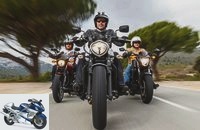
Kawasaki Vulcan S, Honda CTX 700 N and Harley-Davidson Street 750
Entry-level cruiser in a comparison test
At the presentation in mid-February, Vulcan S showed itself to be an easy-going sportsman with a lively engine, while the Honda CTX 700 N with NC 700 modular drive, dual clutch transmission and its unusual appearance claimed the role of the competent Japanese eccentric in last year’s test. And the Harley-Davidson Street 750? During its presentation, it left a very mixed impression: the chassis and especially the engine were convincing, but the processing quality of the Street 750, which was manufactured in India, left a lot to be desired. Has anything changed in the meantime? And which one is the best? Time to compare.
The Kawasaki Vulcan S engine comes from the ER-6
Let’s start with the latest, Kawasaki Vulcan S. 61 hp at 7500 revolutions, 230 kilos, base price around 7300 euros plus additional costs. Its engine comes from the ER-6, its appearance combines classic, low chopper lines with Japanese styling, and its self-imposed claim is to offer the greatest possible beginner-friendliness through compact dimensions and ease of use.
The Kawasaki Vulcan S also largely does justice to this, as the first mount suggests. Very low seat height of 710 millimeters, plus a narrow tank-bench combination, enables everyone to stand securely. However, the footrests are quite far forward, and you have to stretch a little towards the handlebars, which results in a slightly folded seating position compared to the Honda CTX 700 N and the Harley-Davidson Street 750. However, this can be mitigated by means of footrests that can be adjusted in three positions and optionally available handlebars (62 euros) and bench variants (234 euros) and adapted to personal taste and stature.
All articles about the Kawasaki Vulcan S
Honda CTX 700 N with the most comfortable seat
The Honda CTX 700 N is more comfortable from the factory because it has more space, and it also looks more expansive. Your footpegs are in the middle of the moderate cruiser comfort area, just like your handlebars, with their perfect cranking, fall loosely to hand. Very comfortable and suitable for long journeys. In addition, it offers a thickly padded Flaz cushion, from which, in contrast to the firm bench of the Kawasaki Vulcan S or the hard saddle of the Harley-Davidson Street 750, you don’t want to get off.
The tank is a bit wider, but the Honda CTX 700 N with its 710 millimeters seat height, like the Harley-Davidson Street 750 (715 millimeters), should not pose any serious problems. By far the sportiest seating position in the test field offers, hold on, the Street 750. Footrests mounted in the middle and far down, you sit close to the straight handlebar, and a tank that tapers towards the rear – that feels more like a small naked than a cruiser , if it weren’t for the deep seat hollow, in which tall people don’t have enough space to the rear. Nevertheless, the Harley’s seating position works and promises sportiness.
All tests and articles about the Honda CTX 700 N
Harley-Davidson Street 750, Kawasaki Vulcan S and Honda CTX 700 N.
In general, the Harley-Davidson Street 750 (57 hp, 230 kilograms, base price around 8,000 euros including) is not a typical Harley. It is a completely new design with 60-degree V2 (called Revolution X), built in India for a, according to Harley, “young and urban target group”. A Harley for the city’s youth, then? Away with the old braids? Yes, at least as far as the drive is concerned. With water cooling and four-valve technology, it is state-of-the-art without appearing too characterless. In fact, the engine is the figurehead of the street, it pleases with proper running smoothness, great starting torque, strong center and real revving. The clutch (good controllability) and gearbox (smooth-running with only slightly long shifting travel) also contribute to the positive performance of the Revolution X engine.
A 48-horsepower throttle is available at a Harley dealer for little money. Opinions are divided on the Remus accessory rear silencer (around 500 euros) installed on our test machine. Okay, the standard Harley-Davidson Street 750 sounds a bit too subtle. And admittedly, this snotty, unexpectedly bassy shooting turns on, there is a lot of acoustic fine-tuning in it. But no, despite the homologation, this exhaust does not really want to be labeled “socially compatible”, although it does the trick of being louder on the motorcycle than next to it. Its volume is American.
In terms of engines and sound, the Kawasaki Vulcan S and the Honda CTX 700 N are very Japanese, but with completely different characters. The in-line two-cylinder Kawasaki releases a discreet prottteln from the underfloor damper, but mixes in a throaty intake snorkel at medium speeds. And that’s what the 649 cubic parallel twin from the ER-6 likes. It received more flywheel mass, tamer camshafts and an adapted mapping for a stronger center, but remains a barrel organ, especially in the test environment. Although it runs much earlier than its cousin, the tachometer should show at least 4500 tours for proper propulsion. The performance curve flattens out noticeably at the top, but the speed reserves are enormous. The Vulcan S makes it to 100 in a remarkable 5.0 seconds and always shows the two other lights the taillight when it is turned. That might not be typical for cruisers, but it’s always entertaining. A 48-horsepower throttle will be available soon, according to Kawasaki.
The acoustics of the CTX are reserved
Typically cruiser and typically Honda was the drive of the Honda CTX 700 N (base price around 8100 euros plus). Known from the NC 700 and designed from the outset for the 48 hp class, the engine (670 cm³) convinces with its beefy character. From 2000 tours the twin pushes the 230 kilos plus pilot properly, then remains strong in the middle so that it can turn into the limiter early and suddenly. Takes getting used to, but very consistent for an entry-level cruiser. Thanks to the 90 degree crank pin offset and 270 degree ignition interval, the engine run also imitates a Vau engine, and its discreetly pulsating heartbeat is pleasing. The CTX is also acoustically reserved, its monk-like humming is calm, makes you calm and fits perfectly into the picture.
The dual clutch transmission, a Honda specialty and fitted as standard on the Honda CTX 700 N, harmonises very well with the drive. Two automatic modes are available. In “normal” mode, the data center always changes to the next higher gear as early as possible, but holds the gears longer if necessary, i.e. with the throttle grip wider. In “Sport” mode, the shift speed is generally shifted further up. It’s good if you want something more committed.
There is also a manual mode in which the gear is selected using the switch button on the left end of the handlebar and the Honda CTX 700 N can be turned down to the limiter. The pilot can also intervene manually in automatic mode, for example to downshift before a hill or to generate engine braking torque downhill. Pretty complicated? In practice, you quickly get used to the switching points of the DCT and can then enjoy the neatly polished, automated gear changes. Not exactly driving, but for this category of motorcycle in the city and in the country a great gain in comfort and certainly a weighty argument for the CTX-Schwofer.
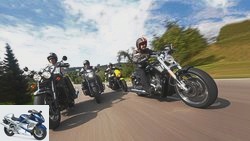
Chopper / cruiser
V-Rod Muscle, Gold Wing F6C, Intruder M 1800 R and Rocket III in the test
Power cruiser in comparison test
read more
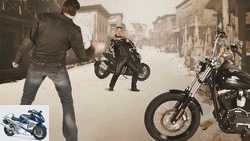
Station wagons, jackets & Pants
Ten cruiser station wagons in the product test
Leather, jeans, synthetic fiber textiles
read more
The Honda drives wonderfully balanced and round
Comfort, that is the motto of the Honda CTX 700 N. Comfort and touring, to be precise, i.e. the greatest possible comfort over a long distance, the Honda is very American in this. But that also works very well for us, because in addition to the already mentioned long-distance seating position and the engine characteristics that encourage casual gliding, both handling and suspension comfort ennoble the CTX to the little sister of the F6B, Honda’s flagship custom excavator. The Honda drives wonderfully well-balanced and round, turns easily and very neutrally, more with composure than indolence.
You can tell that it has a very low center of gravity thanks to the engine tilted forward by 62 degrees. Already in the first corner it conveys a dignified calm. Sure, the spring elements are, as with all test candidates, of simple design. The Honda CTX 700 N has the softest tuning, responds cleanly and thus offers by far the best comfort thanks to the progressive deflection at the hindquarters. Because there must be something to criticize: there is not enough damping at the rear and the spring preload is difficult to achieve. Still, a really good idea.
Harley-Davidson Street 750 has a slight handlebar flapping tendency
The Harley-Davidson Street 750 drives very differently, but not necessarily badly. With its narrow 100-millimeter dachshund tailor front tires it turns in extremely agile and light-footed, but it pays for itself with pronounced jitteriness. It wants to be driven very concentrated in the meandering curves, because this nervousness is accompanied by a very low lean angle. The pegs hit the ground early, and immediately afterwards hard, frame-fixed parts, namely the footrest support on the left and the foot brake pedal (!) And the exhaust on the right. Caution and a forward-looking, rounded driving style are required here, otherwise the road will soon no longer be enough in tight bends. This – let’s call it – character trait can be mitigated a little by fully pretensioning the rear stereo shock absorbers, but beginners should slowly approach the low limit of the street.
Those who like to move cruisers swiftly could possibly even gain something from this “wrestling with a crocodile” charm, after all, the active driving seat position makes it possible to shift weight. The Harley springs honestly tight, its suspension components, in particular the front fork, do not respond as cleanly as the Honda CTX 700 N. The Harley-Davidson Street 750 tends to hit the handlebars a bit, but you have to be in the top Tester attack mode on the go. And the kawa? It is somewhere in the middle in terms of its driving behavior, but without a doubt on the safe side. It steers more greedily, but less neutrally than the Honda, and always wants to dive a little further into the curve. Its lean angle is just as good as that of the CTX.
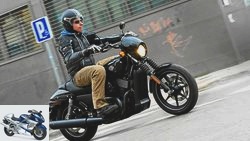
Chopper / cruiser
Harley-Davidson Street 750 put to the test
Baby Harley for the young generation
read more
Brake of the Vulcan S by far the best in the test field
In both cases, the fearful nipples do not rattle too early, and even then you still have some leeway. The Kawasaki Vulcan S also springs tighter, which costs a bit of comfort, but provides more direct contact with the road. However, it is also slightly dampened at the back and therefore likes to hit when rebounding, which results in a somewhat stubborn handling on bad slopes. The bottom line is that it is the cruiser athlete in comparison and, as long as the road is halfway flat, the easiest to control at a brisk pace.
The brakes on the Kawasaki Vulcan S are also very manageable, by far the best in the test field. Its individual discs at the front and rear enable remarkably good deceleration, thanks to very good controllability, strong gripping (with moderately high manual force) and an excellently regulating Bosch ABS. The Honda CTX 700 N can’t quite keep up with this, mainly because its ABS intervenes earlier and sends real blows through the motorcycle with its rough control interventions. Nevertheless, their braking performance is more than adequate overall. Unfortunately not the one on the Harley-Davidson Street 750 (see box “Imminent danger”). It has no ABS, but that should and must change with the 2016 model year, because from then on ABS will be mandatory for all new vehicles across Europe.
Processing of the Harley-Davidson Street 750 largely unfortunate
Until then, on 750 Harley-Davidson Street, you have to brake carefully. Difficult when a braking system acts as bluntly as this one. The Street 750’s front brake, in particular, requires enormous manual force for effective deceleration. In the dry it is hardly possible to overbrake the front wheel, but caution is advised on damp or wet roads, precisely because the Michelin Scrocher 11 is not known for unlimited wet grip. There is also pronounced brake fading.
In our brake tests, the deceleration decreased noticeably in the second attempt when the brakes were fully applied from 100 km / h, before the brake then failed due to overheating on the third brake application. And while we’re grumbling: The workmanship of the Harley-Davidson Street 750 is largely regrettable. With the small Duke and RC single cylinders, KTM has shown at the latest that motorcycles made in India do not have to be cucumbers. Here, however, there are a few flies swimming in the ointment: rough finish of all metal parts (except for the motor), unsightly welds, openly laid plugs on the wiring harness that can be seen from afar, sloppy levers and switches, nasty locksmith nuts on the swing arm, etc..
The Kawasaki Vulcan S surprises in view of its comparatively low price with a clean finish and good equipment.
The tank is easily recognizable off-center, its surface looks wavy in sunlight, and from behind the eye is always caught by the somehow crooked rear light. Even the ignition key doesn’t feel like Premium from Milwaukee, but rather like a cheap bike lock from a one-euro shop. Ouch, Harley-Davidson, you can do better than that. In order to save the honor of Harley-Davidson Street 750, it should be said that not everything about it seems unkind. The fender is real sheet metal. What looks like a rim edge sticker is actually milled. And the sparkling clean engine shows how things could be done better. Granted, this is the cheapest Harley, but that is exactly how it works overall.
The two Japanese give no reason to munch on. Especially the Kawasaki Vulcan S surprises in view of its comparatively low price with a clean finish and good equipment. Just one example: The Honda CTX 700 N and the Harley-Davidson Street 750 roll around coyly on the simplest steel profile swingarms, but the rear wheel guidance of the Kawa is quite impressive. There are stylish aluminum covers on the engine, and the high-quality stainless steel manifold also shows that savings have not been made at the wrong end. There is also an adjustable brake and clutch lever as well as a speedometer unit with extensive information.
Street 750 speedometer nice and simple
The Honda CTX 700 N doesn’t make a mistake here either, but it does have to hide its massive drive train, which is not exactly handsome, under lush plastic. Your speedometer unit is digital, difficult to read, but also blessed with a decent amount of information. The beautiful, simple speedometer of the Harley-Davidson Street 750 shows nothing besides the speed except the daily and total kilometers, but before we are accused of Harley bashing, let’s really consider this purism.
Finally, the consumption: Harley-Davidson Street 750 good (4.1 liters / 100 kilometers), Kawasaki Vulcan S better (3.8 liters), Honda CTX 700 N best (3.5 liters). All in all, it makes a crystal clear conclusion: The Honda clearly wins due to its balance. There is no argument about taste. The Kawasaki is recommended because of its low price and sporty note, including top brakes. And the Harley-Davidson? She makes little effort to please. One could accept that were it not for shortcomings in security. Even the successful engine doesn’t tear anything out. Red lantern.
Braking problems on the Harley-Davidson Street 750
The system of the Harley-Davidson Street 750 overheated, the pressure point moved to the handlebars.
Brake Harley-Davidson Street 750
It smoked like a sausage stall. ”This is how colleague Stefan Gluck described the failure of the Street 750 brake system during the test. The first measurement was tricky due to the very high hand strength, doughy pressure point and the lack of ABS, but experienced testers achieved a very respectable 9.6 m / s² average delay. However, the second measurement already showed clear fading (after turning and accelerating again and thus a little cooling down). On the third attempt, the brake on the Harley-Davidson Street 750 completely failed.
The system of the Harley-Davidson Street 750 overheated, the pressure point moved to the handlebars. Possibly the pads warped (with considerable smoke development) and thus prevented an effective deceleration: 5.7 m / s² is achieved with the rear wheel and engine brake. The result: an incredible 67.7 meters of braking distance or a remaining speed of 64.7 km / h. Where the Kawasaki is already. And that, mind you, also during the third brake application, because the brake system of the Kawasaki Vulcan S, like that of the Honda CTX 700 N, was stable. So: be careful when driving on passes!
Technical specifications
MOTORCYCLE test results
The clear winner in the comparison test: The Honda CTX 700 N. It is followed by the Kawasaki Vulcan S and the Harley-Davidson Street 750.
1. Honda CTX 700 N
Clear winner thanks to classic Honda virtues. Wonderfully balanced driving behavior, a coherent drive, very convenient, convenient automatic gearshift. Not a pulse accelerator, but a pulse calmer in the best sense. The Honda CTX 700 N is for connoisseurs.
2. Kawasaki Vulcan S.
Lively and agile, but not quite as balanced and comfortable as the Honda. In addition to the lower price, decent performance and the sporty driving behavior, the brakes also speak for the Kawasaki Vulcan S..
3. 750 Harley-Davidson Street
You need Harley-Davidson glasses to prefer the Harley-Davidson Street 750 in this field. Your engine speaks for you, otherwise not much. And the fun stops with the brakes.
Related articles
-
Comparison test Honda Hornet 600 ABS, Kawasaki Z 750 ABS and Triumph Street Triple
Artist comparison test Honda Hornet 600 ABS, Kawasaki Z 750 ABS and Triumph Street Triple Weekend Warriors Life is almost sterile. Engines…
-
fact Concept comparison Honda CBR 1100 XX Kawasaki ZX-12 R Suzuki GSX-R 1000 Suzuki GSX 1400 Yamaha FZS 1000 Fazer Yamaha FJR 1300 Six bombs The six …
-
Comparison test Suzuki SV 650, Honda CB 650 F, Kawasaki ER-6n, Yamaha MT-07
www.bilski-fotografie.de 34 pictures www.bilski-fotografie.de 1/34 They are the hottest candidates among the middle class naked bikes ….
-
Harley-Davidson Street Glide and Honda Gold Wing F6B put to the test
Gargolov 31 photos Gargolov 1/31 Shortened at the front as if with a scythe, at the back as if compressed with a hammer: excavators look strangely…
-
Harley-Davidson Sportster Iron 883 and Harley-Davidson Street 750 in comparison test
www. 25th photos www. 1/25 Harley-Davidson wants to expand its fan base, the Harley-Davidson Street 750 is intended to inspire…
-
factstudio.de 29 photos fact 1/29 One against all. Ducati SuperSport S in comparison test with Suzuki GSX-S 1000 F, Kawasaki Z 1000 SX, Honda VFR 800 F…
-
Comparison test Honda XL 600 V Transalp against Kawasaki KLE 500
Comparison test Honda XL 600 V Transalp against Kawasaki KLE 500 Silent Stars Never made it big. Others collect prices, they are cheap. Now the …
-
Kawasaki Vulcan S and Honda Rebel in the test
www.bilski-fotografie.de 16 photos bilski-fotografie.de 1/16 The displacement dwarfs Kawasaki Vulcan S and Honda CMX 500 Rebel in comparison….
-
Kawasaki Ninja 300, KTM RC 390, Honda CBR 300 R and Yamaha YZF-R3 in the test
markus-jahn.com 42 photos markus-jahn.com 1/42 Four bikes compete to compare the third-liter athletes. markus-jahn.com 2/42 The Honda fork also responds…
-
Top test Harley-Davidson VRSCR Street Rod
Gargolov Top test Harley-Davidson VRSCR Street Rod The interceptor That winter was tough. Summer will be too. Because you could have a Harley stuck in…